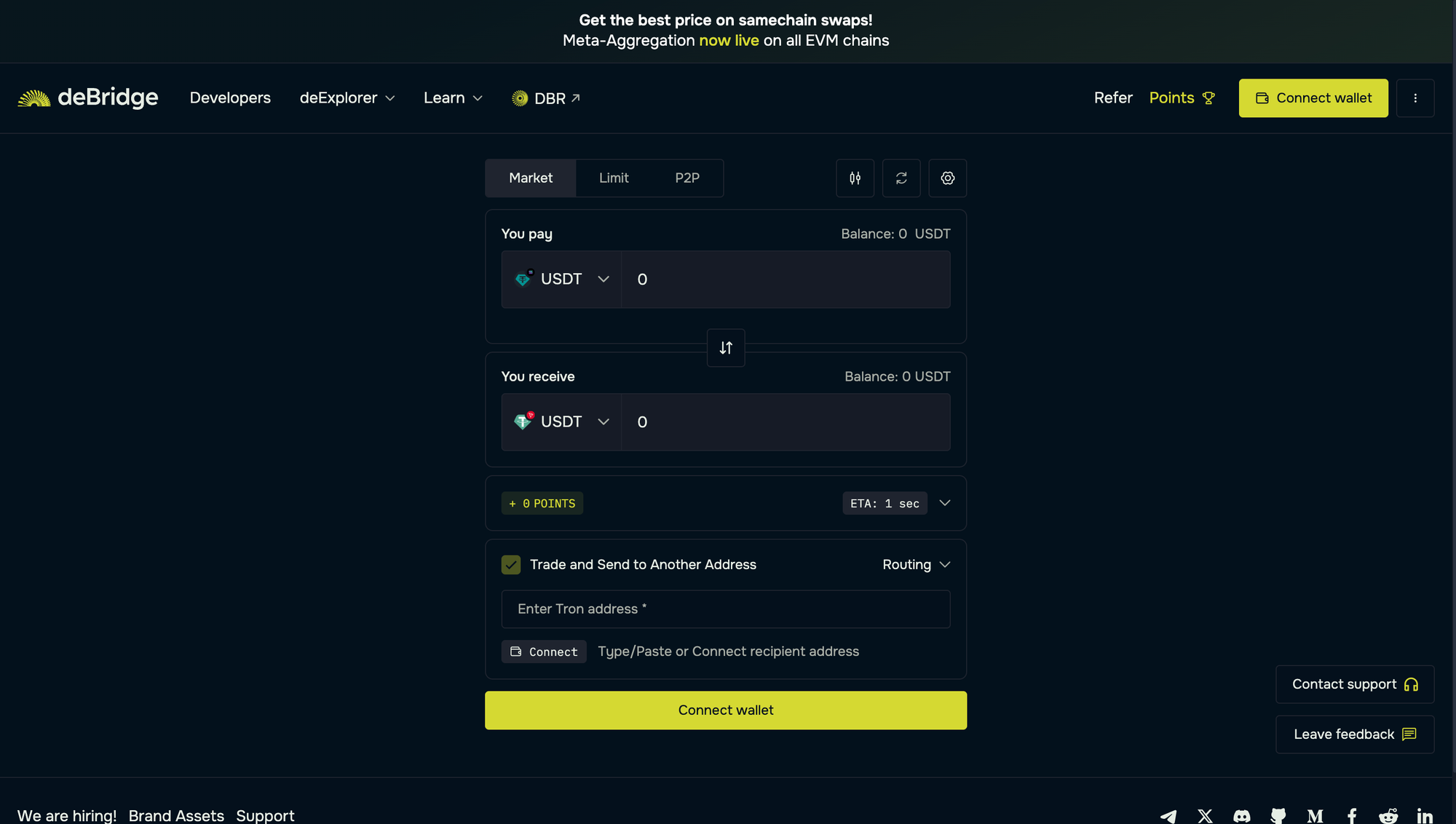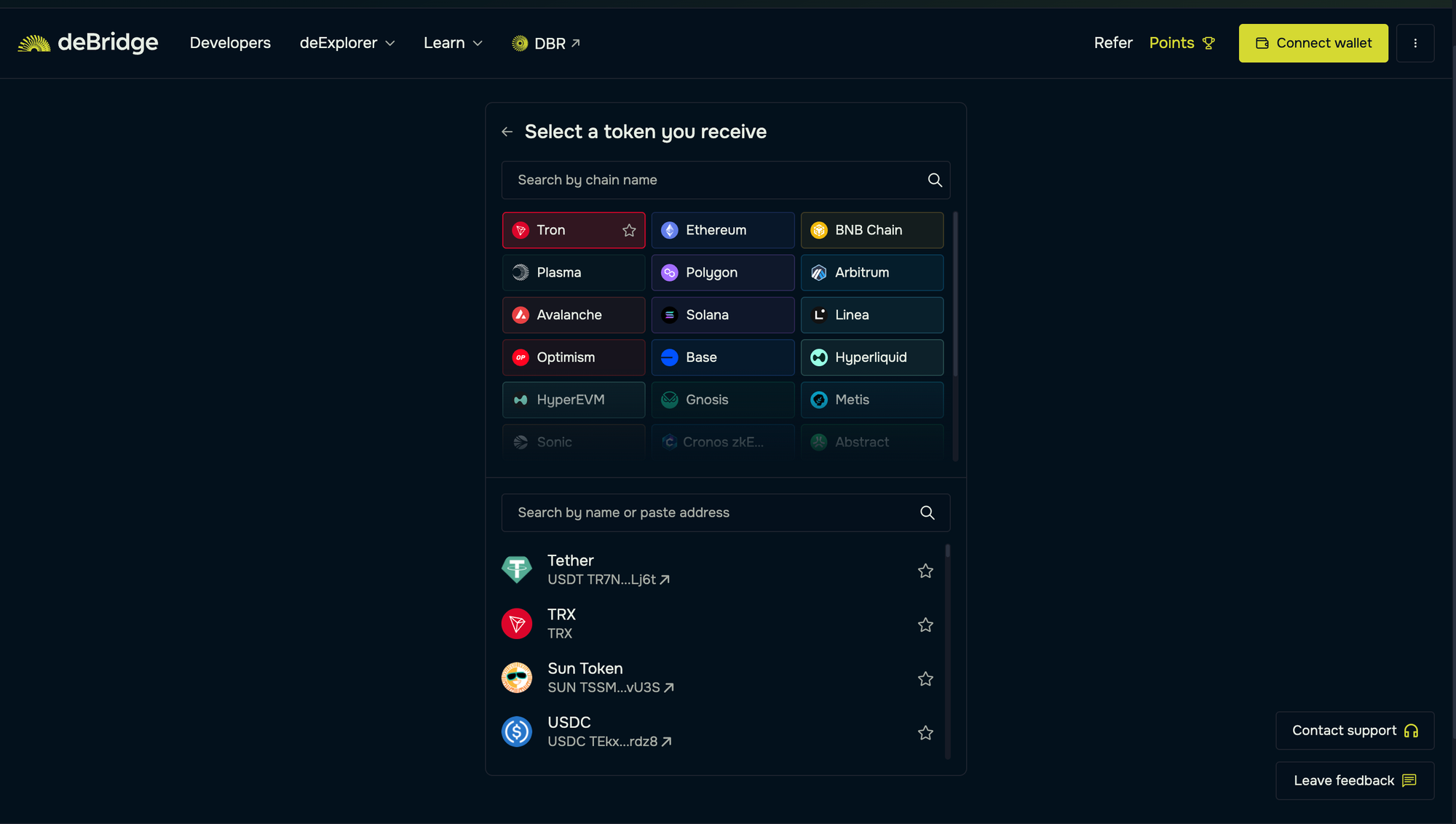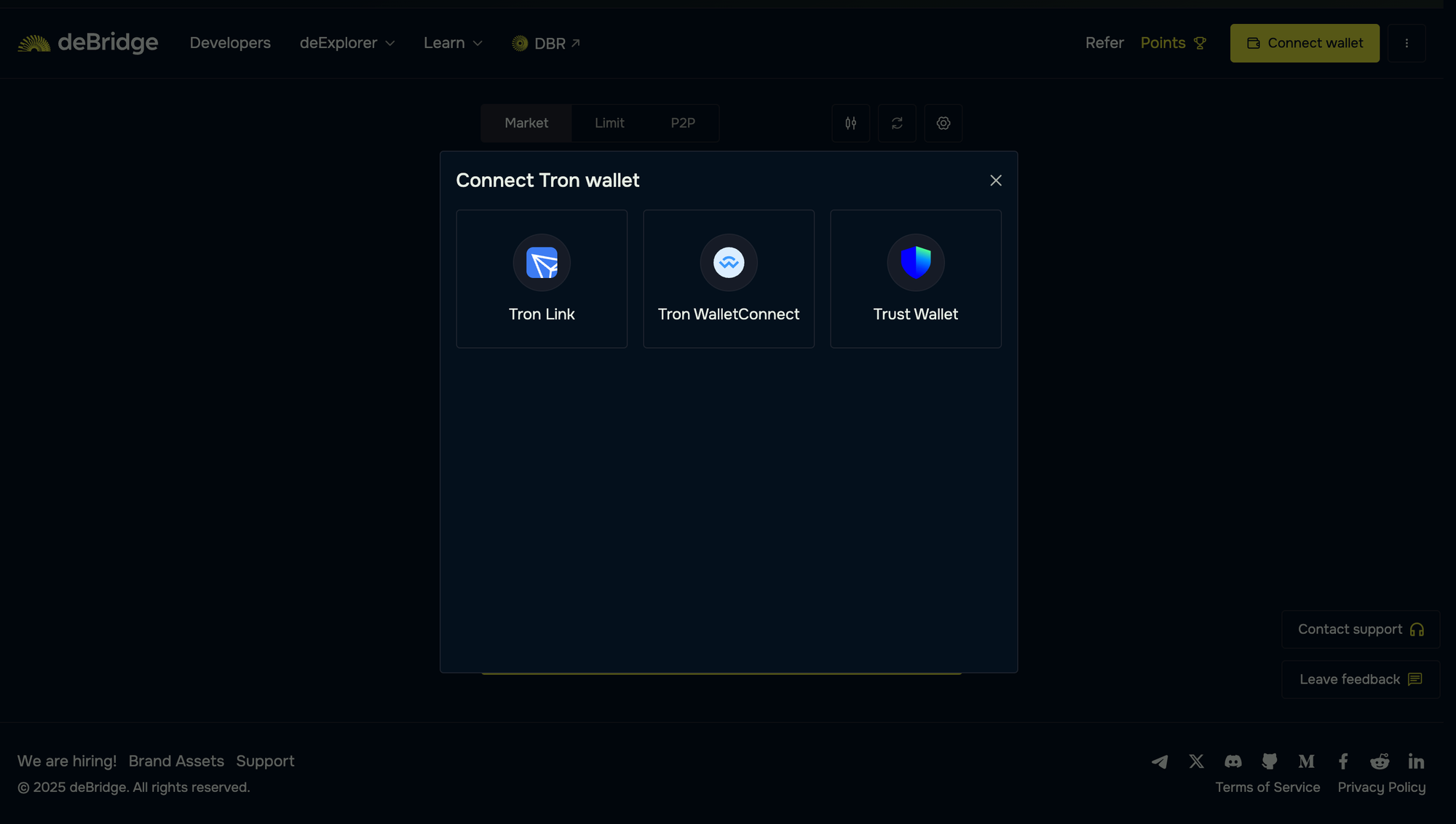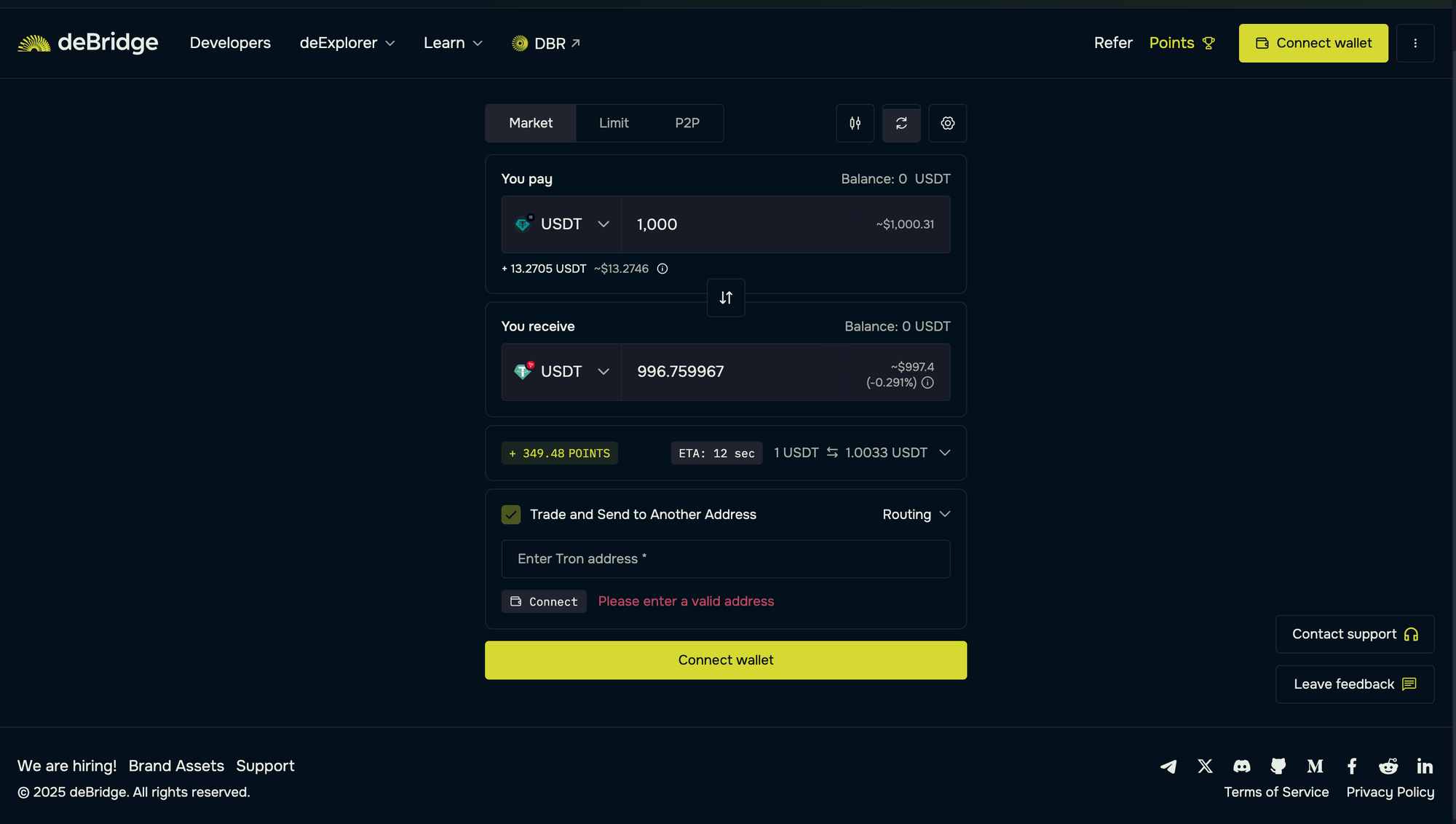How to Swap USDT to Tron In Seconds with deBridge

Table of Contents
- Key Takeaways
- Why Swap USDT to TRON
- Common Issues With USDT to Tron Swaps
- Step-by-Step: How to Bridge USDT to Tron with deBridge
- What Makes deBridge Different from Other DEXs
- For Developers: Add USDT to Tron Swaps to Your App
- deBridge Security Summary
- Frequently Asked Questions (FAQs)
- Related Resources
DeFi is growing, and we’re all a part of the movement.
In the fast-moving world of decentralized finance (DeFi), USDT (Tether) remains the stablecoin of choice for millions of users and traders.
Swapping USDT to TRON (TRC-20) enables faster transactions, better gas costs, and access to one of the biggest ecosystems in crypto. Yet, performing this cross-chain swap through conventional DEXs or bridges often involves friction from wrapped tokens, slippage, pooled-liquidity risks, and delays.
That’s where deBridge comes in. Built with a 0-TVL architecture and real-time execution, deBridge eliminates slippage and wrapped tokens while minimizing the attack surface, making it the fastest, most secure way to swap USDT to Tron in seconds.
Key Takeaways
- Swapping USDT to Tron gives users access to faster, cheaper, and more reliable stablecoin transfers.
- Tron is the most widely used blockchain for USDT transactions globally.
- Traditional swaps involve risks such as slippage, wrapped tokens, and pooled liquidity exposure.
- deBridge delivers native TRC20 USDT with zero slippage, no wrapped tokens, and real-time settlement.
- Developers can integrate seamless USDT-to-Tron swaps using deBridge APIs.
Why Swap USDT to TRON
Tron is the biggest network for USDT (~50% of all USDT), making it the blockchain settling the most stablecoin transactions worldwide. It is built to host dApps with high speed, scalability, and low fees.
Value Framing
Every blockchain has its strengths. While Ethereum offers deep liquidity and BNB Chain provides retail participation, TRON stands alone in one critical metric: stablecoin efficiency.
It is designed specifically for high-volume transactions, now processing billions of dollars in USDT transfers daily. For users or institutions seeking cost-efficient onchain payments, Tron’s USDT is a practical option.
Use Cases
- Cross-Chain Arbitrage: Move liquidity to where it’s most profitable or where yield opportunities are better.
- Payments & Remittances: Instantly settle transfers worldwide at a fraction of the cost.
- DEX & Perp Trading: Access Tron-based trading platforms with deep liquidity and near-zero gas.
- Stablecoin Treasury Management: Projects or DAOs diversifying between ecosystems for treasury stability.
For DeFi builders, bridging USDT to Tron offers a fast, cost-effective, and better ecosystem, allowing them to serve a broader base of users without any compromise.
Common Issues With USDT to Tron Swaps

The idea of bridging is often misunderstood because legacy solutions have worked differently. They cause more problems than they solve, including asset delays, wrap risks, wallet limitations, and more.
Most Common Pain Points
- Wrapped Tokens: Many bridges don’t deliver native TRC20 USDT; instead, users receive “wrapped” or synthetic versions.
- Pooled Liquidity Risks: Centralized liquidity pools can be hacked, drained, or mismanaged.
- Limited Wallet Support: Some bridges only support a handful of wallets or token standards.
- Settlement Delays: Transactions may take minutes or hours due to liquidity routing or manual validation.
- CEX Reliance: Many users still rely on centralized exchanges to move stablecoins between chains, resulting in withdrawal limits and KYC delays.
How deBridge Solves Them
deBridge removes the bottlenecks and risks of liquidity pools by enabling value and information to flow instantly across the DeFiverse with deep liquidity and guaranteed rates.
- Real-time Bridging: Transfers settle in seconds with instant finality. No waiting, no stuck transactions.
- Native Assets Only: ETH in, native BNB out. No wrapped tokens.
- 0-TVL Architecture: No user funds are stored in smart contracts or liquidity pools, eliminating honeypot risk.
- Universal Wallet Support: Compatible with EVM wallets like MetaMask, WalletConnect, Coinbase Wallet, Trust Wallet, and others. Tron wallets supported include TronLink, Trust Wallet, and Tron WalletConnect.
Step-by-Step: How to Bridge USDT to Tron Using deBridge

deBridge offers a quick bridging solution to transfer assets between Solana and any asset on Tron, or vice versa. Here are the simple steps to bridge your crypto assets efficiently:
- Visit https://app.debridge.finance
- Select the source chain and asset you’d like to bridge. Here, we will select Solana as the source chain and USDT as the asset.

- Next, select the destination chain and asset you’d like to receive. Here, we will choose Tron and USDT as the asset on the target chain.

- Connect your Solana wallet as the source and Tron wallet as the destination.

- Enter the USDT quantity and review the transaction details.

- Confirm trade and sign the ensuing transactions to receive native TRX in your Tron account.
Pro Tips
- Make sure you have sufficient TRX in your destination chain (Tron) for future transactions.
The bridging process is simple and only takes a few seconds to complete. You will receive the bridged assets in your desired Tron wallet. Technical users can also inspect the transaction(s) on the Tron explorer.
What Makes deBridge Different from Other DEXs
Speed and security are the biggest factors that make deBridge different from other DEXs. Unlike traditional DEXs, which rely on liquidity pools and wrapped assets, deBridge takes a different approach by adopting a 0-TVL architecture for better security and zero-risk in cross-chain swaps.
Comparison Table
Key Differentiators
- Zero-TVL Design: No liquidity pools, no counterparty risk
- Real-Time Execution: Swaps settle in seconds, not blocks.
- Native Assets: Always receive authentic tokens — no wrappers.
- Zero Slippage: Guaranteed execution at quoted rates
- Developer Ready: Robust SDKs and APIs for app integration.
- Wallet-Agnostic: Works with every major wallet provider.
- Proven Security: 30+ audits, never exploited.
With over $16 billion in transaction volume, deBridge is trusted by major wallets and dApps, including Phantom, Trust Wallet, Jupiter Exchange, and more. It has faced zero downtime even during network spikes and helped users move crypto assets across blockchains.
For Developers: Add USDT to Tron Swaps to Your App

Building cross-chain functionality into your dApp should be a no-brainer and doesn’t require months of development or complex infrastructure. With deBridge, developers can enable ETH ↔ BNB bridging in just a few lines of code using our developer APIs.
Whether you're building a DEX, NFT platform, onchain game, or wallet, integrating deBridge opens a seamless way to onboard users across Ethereum and BNB Chain. Now, with an added functionality, you can explore how to fetch real-time DeFi data with deBridge Hooks.
Why Integrate deBridge
Developers can embed cross-chain USDT-to-Tron swaps directly into their apps using deBridge’s widget or API.
- One-Line Integration: Add cross-chain functionality without rewriting your stack.
- Simple API Endpoints: Easily access bridging routes, quotes, and real-time execution.
- Instant Finality: Every transaction settles natively in real-time.
- Affiliate Revenue Model: Earn fees from every trade executed through your integration.
- Multi-Chain Support: Integrate once and support 25+ chains out of the box.
deBridge Security Summary

Security is our #1 priority
Unlike traditional bridges that rely on wrapped assets or pooled liquidity, which expose user funds to potential exploits, deBridge uses a 0-TVL architecture that avoids liquidity pools and eliminates attack surfaces.
deBridge keeps user funds safe throughout the order lifecycle. It ensures funds arrive in the destination wallet before the transaction is finalized, giving you the confidence to move funds across 25+ chains in seconds.
Why Users Trust deBridge
deBridge proves that security and speed can coexist in DeFi.
- 0-TVL Architecture: Funds move directly from sender to receiver — deBridge never holds user liquidity.
- Security Audits: deBridge has undergone 30+ security audits independently verified by top firms, including Halborn, Zokyo, and Ackee.
- Bug Bounty Program: The $200k bug bounty program remains unclaimed, a testament to robust security.
- Funds Delivered Before Finalization: Transactions are atomic, ensuring completion or refund.
